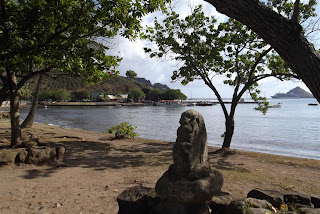January 26 was a sea day during which I managed to write the text for the Bay of Islands Blog. Michael liked it so much that he edited it slightly and used it on his blog (with attribution and my permission.) We were both using his computer until that point. My power supply cable was lost somewhere on the way to the Silver Whisper, possibly when I removed the computer from its backpack at the Denver airport. The computer support specialist, David, was able to order a new cable from Dell for delivery at Auckland. I was most relieved and grateful that it arrived as promised. I spent a lot of time on the sea day between Auckland and Wellington transferring files and pictures and never did get the blog posted. It is now January 31 as I write this. We have been busy four days straight visiting Wellington, Akaroa, Dunedin and cruising Dusky and Milford Sounds. I posted the Bay of Island blog this morning.
We docked at Wellington, New Zealand's capital, Sunday January 28. New Zealand is pretty laid back most of the time but especially so on Sundays. Our plan was to avoid the tours, explore the downtown, the civic square, and visit the Te Papa Museum. We accomplished all our objectives. Silversea provided a complimentary shuttle bus to the downtown business district. Michael and I were on the first one at 9:00 AM. We were in a nearby McDonald's by 9:30 to use the free Wi-Fi and check e-mail.
The Wellington cable car to Kelburn at the top of one of the mountains surrounding the small city was just down an alley from McDonald's. We purchased round trip tickets and spent a pleasant hour or so wandering the Cable Car Museum, the Botanic Gardens and the Carter Observatory on top. Back in the city, Michael and I strolled east on Lambton Quay to the parliament buildings. Lambton Quay is a street that runs where the original waterfront was before the Wellington city leaders decided in the late eighteen hundreds to fill part of the harbor to make more land for downtown expansion. All of New Zealand is earthquake prone. As a result, stone buildings built on landfill suffer frequent damage. Interestingly, wooden structures often survive while stone ones do not. Oddly enough, the second largest wooden building in the world is in Wellington. In general, Wellington architecture is a mix of styles and materials. Since the major earthquake of 2011, the building codes in all of New Zealand have been revised requiring stronger foundations and earthquake resistant construction. We saw a number of major buildings posted with condemned signs. There is still controversy whether to demolish them and build new or spend small fortunes retrofitting historic buildings. As a result, many condemned buildings are just sitting there.
Michael and I looked at the current government buildings (steel, stone and glass) and the old government buildings, now used as the courthouse (wooden) then walked on Bunny Street to the railway station. The terminal is a 1920's structure, somewhat updated and still in daily use. There appears to be a reasonably vibrant local rail system and some long distance service as well.
We returned to the Whisper for lunch. Nothing much beyond the aforementioned McDonald's was open on a Wellington Sunday. After lunch, we took the shuttle bus again to the spot marked on the tourist map as the drop off point for cruise ship tourists. We were sharing the day in Wellington with tourists from another cruise ship, the Crystal Symphony. It was amusing that some Crystal passengers each trip tried to get on the Whisper shuttle bus but no Silversea passengers ever tried to board the Crystal shuttle. There were far more of them so perhaps the odds of them messing up were greater. I like to think that Silversea passengers are more discriminating.
I had plotted out a route along the shoreline for Michael's and my walk to the TePapa Tongarewa or New Zealand National Museum. We saw many people out for a Sunday stroll in the waterfront parks. There were families and groups of young people walking, laughing and talking . Jumping into the water seemed to be a big sport among the young men. We saw a sign explaining a complicated looking old steam crane. The towering crane has been partially restored; a preservation group was raising money to complete it. We came upon a farmers market and food fair near the museum. The vendors were packing up at 1:00 PM but we saw an array of international fast food that smelled intriguing and wonderfully attractive. The vegetables on display were very large and colorful.
The museum itself is modern and well done. Michael and I are not used to so many interactive exhibits but the youngsters were enjoying them a lot. Tired after seeing three extensive exhibits, we found a Wi-Fi hot spot on the second floor. I sat and rested while Michael called another Boulder friend on Skype. The Silver Whisper was scheduled to sail at 5:30 PM and we wanted to catch the next to last shuttle bus to the ship by 4:00. In order to get back to the pickup point we needed to leave the museum by 3:30. We made a whirlwind tour of the Maori exhibits for the next half hour and headed back. The Te Papa is a museum I would like to spend several days exploring sometime.
The weather in often-windy Wellington had been sunny, clear and warm. We had a marvelous day seeing the sights. Michael had not been able to dock on his previous cruise visit due to high winds. I was happy that he finally had a chance to see a new place though not a new country.
We enjoyed another sail out past beautiful scenery while enjoying a beverage on the rear deck.


















































